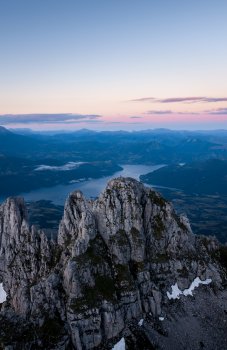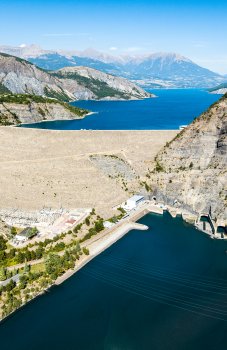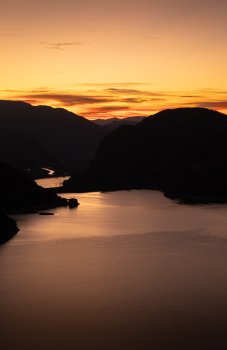Take a look at this man-made lake, its life cycle and uses, and learn about the scientific data forecasting the impact of global warming.
2. Shared and regulated use of water resources.
EDF Hydro Méditerranée's facilities on the Durance, Verdon, Buëch and Bléone rivers form one of the most powerful hydroelectric deposits in France.
They produce renewable energy that is essential for the electricity needs of the Southern Region and for the challenges of carbon neutrality. In addition to generating electricity, these dams and power plants also meet other water-related needs (irrigation, drinking water, etc.). Lac de Serre-Ponçon is the main reservoir, storing 1.2 billion m3 of water, supplemented by water from the Sainte-Croix and Castillon lakes on the Verdon.
The colossal structure retains 1.27 billion m3 of water over an area the size of Lake Annecy.
How is this water resource distributed?
- The agricultural reserve guarantees up to 200 million m3, including 156 million m3 between July 1 and August 31 (i.e. 6 meters of water level) for 80,000 m2 of irrigated land.
- Drinking water supply for 3 million people throughout Provence.
- Instream flow ,i.e. a minimum flow that permanently guarantees the life, circulation and reproduction of species living in watercourses .
- Lake tourism on Lac de Serre-Ponçon, which supports over 1,000 direct jobs and accounts for 40% of summer tourism in the Haute-Alpes region .
- Renewable electricity in the South of France, producing the energy needed by 2.1 million people every year, equivalent to the population of 3 times Marseille .
Interconnected hydroelectric schemes on a regional scale:
At the heart of water resource sharing Serre-Ponçon is the first of the 16 dams and 24 power stations that make up the Durance-Verdon hydroelectric chain. It is the main reservoir, feeding the 250 km-long EDF Durance canal.
Further information is available directly from the partner sites:
EDF: www.edf.fr/hydro-mediteranee
SMAVD (Syndicat Mixte d'Aménagement de la Vallée de la Durance): https://www.smavd.org/la-durance/lamenagement-hydroelectrique/
CED (Commission Exécutive de la Durance): https://www.irrigation-ced-durance.fr/
3. How does EDF manage the filling of Lac de Serre-Ponçon?
The reservoir lives to the rhythm of incoming and outgoing water flows. The filling and lowering phases of the lake normally follow fairly regular cycles. In spring, as the snow melts, the Ubaye and Durance rivers, often swollen by rainfall, allow the reservoir to fill up in summer. In summer, water from the lake is used to meet downstream needs, particularly for agricultural purposes, at a time when low-water flows in the rivers are sometimes insufficient.
Although autumn is highly variable, winter remains the ideal time
to produce renewable, low-carbon electricity, in response to peaks in
consumption peaks.
To generate electricity, particularly during winter peak periods
eDF experts are constantly monitoring the thickness of the snowpack
snow cover. The aim is to ensure that this "stock" will be sufficient to fill the lake when the snow melts
melt, enabling water sports activities and the supply of water for all other uses.
From March to June, energy production is adapted to take into account the filling of the reservoir and the replenishment of the water reserve.
Throughout the summer, only the volumes of water needed for irrigation downstream, for the minimum flow left in the river, and for drinking and industrial water consumption are released from the lake. In autumn, hydroelectric power generation will once again take priority, and a new cycle begins
new cycle
Some useful words?
Marnage: The lake elevation corresponds to the height of the water level. Depending on how the lake is used for energy generation, it can vary from a maximum level (full lake) of 780 m NGF to a minimum level of 725 m NGF. The level varies according to energy requirements and downstream water abstraction. At the dam outlet, the water will then supply various uses. This variation in water level is called tidal range. It creates lunar landscapes.
Snowmelt: a climatic phenomenon involving the transformation of snow cover into water under the influence of milder temperatures. Melting generally takes place in spring, ideally to refill the lake before summer demand downstream.
Low-water flow: Lowest average level of a river .
Multi-usage: capacity organized by EDF to use the same water resource for multiple purposes (electricity, natural environment, agriculture, tourism, etc.) .
1. A dam with multiple functions in a few words
The different missions
The dam's various missions:
- Agricultural irrigation of the lower Durance.
- Renewable electricity supply.
- Supply of drinking and industrial water.
- Tourism.
- Combating the effects of drought and limiting the impact of flooding.
2. Shared and regulated use of water resources.
EDF Hydro Méditerranée's facilities on the Durance, Verdon, Buëch and Bléone rivers form one of the most powerful hydroelectric deposits in France.
They produce renewable energy that is essential for the electricity needs of the Southern Region and for the challenges of carbon neutrality. In addition to generating electricity, these dams and power plants also meet other water-related needs (irrigation, drinking water, etc.). Lac de Serre-Ponçon is the main reservoir, storing 1.2 billion m3 of water, supplemented by water from the Sainte-Croix and Castillon lakes on the Verdon.
The colossal structure retains 1.27 billion m3 of water over an area the size of Lake Annecy.
How is this water resource distributed?
The agricultural reserve guarantees up to 200 million m3, including 156 million m3 between July 1 and August 31 (i.e. 6 meters of water level) for 80,000 m2 of irrigated land.
Drinking water supply for 3 million people throughout Provence.
Instream flow ,i.e. a minimum flow that permanently guarantees the life, circulation and reproduction of species living in watercourses .
Lake tourism on Lac de Serre-Ponçon, which supports over 1,000 direct jobs and accounts for 40% of summer tourism in the Haute-Alpes region .
Renewable electricity in the South of France, producing the energy needed by 2.1 million people every year, equivalent to the population of 3 times Marseille .
Interconnected hydroelectric schemes on a regional scale:
At the heart of water resource sharing Serre-Ponçon is the first of the 16 dams and 24 power stations that make up the Durance-Verdon hydroelectric chain. It is the main reservoir, supplying nearly 250 km of water to the EDF Durance canal.
3. How does EDF manage the Serre-Ponçon dam?
The reservoir lives to the rhythm of incoming and outgoing water flows. The lake's filling and lowering phases normally follow fairly regular cycles. In spring, as the snow melts, the Ubaye and Durance rivers, often swollen by rainfall, allow the reservoir to fill up in summer. In summer, water from the lake is used to meet downstream needs, particularly for agricultural purposes, at a time when low-water flows in the rivers are sometimes insufficient.
While autumn is highly variable, winter is the ideal time to generate renewable, low-carbon electricity to meet peak demand.
To generate electricity, particularly during winter peak hours, EDF experts constantly monitor the thickness of the snowpack. The aim is to ensure that this "stock" will be sufficient to fill the lake when the snow melts, thus enabling water sports activities and the supply of water for all other uses.
From March to June, energy production is adapted to take into account the filling of the reservoir and the replenishment of the water reserve.
Throughout the summer, only the volumes of water needed for irrigation downstream, for the minimum flow left in the river, and for drinking and industrial water consumption are released from the lake. In autumn, hydroelectric power generation will once again take priority, and a new cycle will begin.
Some useful words?
Marnage: The lake level corresponds to the height of the water. Depending on how the lake is used for energy generation, it can vary from a maximum level (full lake) of 780 m NGF to a minimum level of 725 m NGF. The level varies according to energy requirements and downstream water abstraction. At the dam outlet, the water will then supply various uses. This variation in water level is called tidal range. It creates lunar landscapes.
Snowmelt: a climatic phenomenon involving the transformation of snow cover into water under the influence of milder temperatures. Melting generally takes place in spring, ideally to refill the lake before summer demand downstream.
Low-water flow: Lowest average level of a river .
Multi-usage: capacity organized by EDF to use the same water resource for multiple purposes (electricity, natural environment, agriculture, tourism, etc.) .
4. The lake shore in a few words
The lake shore
The lake level is given in NGF meters, the measurement used for all altitudes in France, which refers to sea level.
780 m NGF
Maximum filling level
(full lake)
775 m NGF
Tourist compatibility level
(up to which the operation of all bathing and nautical facilities remains qualitative)
725 m NGF
Minimum operating elevation
5. Development of the Serre-Ponçon reservoir
6. VIGIE DURANCE VERDON SMAVD interface
The Syndicat Mixte d'Aménagement de la Vallée de la Durance invites you to observe inflows and outflows in the Durance watershed, as well as dam lake levels. This makes it possible to observe the state of resources and needs in real time. Updated every 10 days from March 10 to September 30, the Vigie-Durance-Verdon web interface presents estimates of the main inflows.
https://www.smavd.org/ressources/vigie-durance-verdon/







